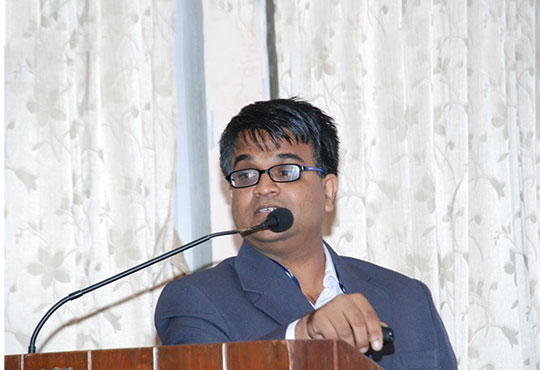Digital Learning Platforms Towards A Better India!

Sachin Sadare, Founder & Director, Digital Dojo India
Education is changing! Though it is important to know how it is changing, it is more important to understand why it is changing. And from an Indian context why it needs to change?
Gone are the days when a professional degree course could get you a job. Or make you ready for some employment. These days the courses, including engineering or medicine or marketing or finance, are not yet ready to provide meaningful educational value. In most cases, it is a mere formality to get one educated. Education is what gives us a character to face the future and to use it for the betterment of individuals, the society, the country and ultimately humanity.
Unfortunately, the gap between what is required to do so and what is being imparted to students in the colleges is ever increasing. And it does not seem that this gap will ever close out.
"It is believed that by 2020, there will be roughly 10 million digitally educated students and working professionals in India"
Unless we change the way we educate ourselves and others. Digital education is the way forward and digital learning platforms are the tools to equip ourselves with meaningful education and knowledge. Globally the online education model has already picked up. Everyone is learning from everyone. Our passion and our skills are teachable. There are platforms that allow such skills to be transferred. The innovation of the west has made it possible to offer such life-transforming education to be exchanged between people. The ability to share niche skills and expert knowledge with a vast amount of people is what makes digital learning a great asset for human education.
Let me now focus on the impact of digital education and digital learning platforms from an Indian context.
India is a country of youth. However, there is a massive mismatch between the demand for quality education and the supply of quality education. The supply side is constrained by the number of academic institutes, the learning facilities, the teachers, the libraries and so on. It is impossible to make quality education available to every Indian through the traditional way of teaching. It will be a costly and time-consuming option. India has to embrace the digital way of educating itself. And India has to do it soon.
The good thing is that the trends from India not just the metro cities but also the tier 2 and tier 3 cities are very encouraging from this perspective. It is believed that by 2020, there will be roughly 10 million digitally educated students and working professionals in India. Compare that with about a million in 2015 and you will know the scale at which digital education is catching up in India. The market size is expected to be about 2 billion US dollars in comparison with a nonexistent market in 2015.
Growth of the mobile smartphones and high data rate internet bandwidth at affordable prices are the two most critical reasons for the growth of digital education in India. It is amazing as to how the rise of technology has a very strong correlation with the rising aspirations of the Indian semi-urban and rural youth. Digital education is more embraced in the interiors of India the tier 2 and tier 3 cities because students there have higher aspirations in life. They are no longer content with what their parents had. They want to conquer the world with their skills & knowledge. Unfortunately, these students have so far been disconnected from the metropolitan high-value education and had to settle for what was available.
With digital learning platforms, this is no longer true. The semi-urban and rural students now have access to the best possible teachers and the best possible learning content. They can now aspire to compete with the best in the world (not just India) from their hometowns. This is one of the biggest trends we see in India over the last decade. More and more semi-urban and rural students are getting acknowledged for their skills and knowledge. This, according to me, is the biggest impact on digital education and digital learning platforms can have on India, as India progresses towards a digital economy.
What this means is that students from all over India have access to the best educational content, the best teachers, and the best teaching institutes. And as we move towards 2020, we will start seeing this translate into a higher number of jobs for students and more meaningful education.
Sachin Sadare, Founder & Director
An entrepreneur with excellent consulting, training, public speaking and negotiation skills, Sachin Sadare is the holding the chair of Founder & Director at Digital Dojo India. He has more than 17+ years of experience in envisaging and delivering digital solutions to corporate, SMBs and academic institutes. He is an alumnus of Melbourne Business School, University of Melbourne, Australia.
Gone are the days when a professional degree course could get you a job. Or make you ready for some employment. These days the courses, including engineering or medicine or marketing or finance, are not yet ready to provide meaningful educational value. In most cases, it is a mere formality to get one educated. Education is what gives us a character to face the future and to use it for the betterment of individuals, the society, the country and ultimately humanity.
Unfortunately, the gap between what is required to do so and what is being imparted to students in the colleges is ever increasing. And it does not seem that this gap will ever close out.
"It is believed that by 2020, there will be roughly 10 million digitally educated students and working professionals in India"
Unless we change the way we educate ourselves and others. Digital education is the way forward and digital learning platforms are the tools to equip ourselves with meaningful education and knowledge. Globally the online education model has already picked up. Everyone is learning from everyone. Our passion and our skills are teachable. There are platforms that allow such skills to be transferred. The innovation of the west has made it possible to offer such life-transforming education to be exchanged between people. The ability to share niche skills and expert knowledge with a vast amount of people is what makes digital learning a great asset for human education.
Let me now focus on the impact of digital education and digital learning platforms from an Indian context.
India is a country of youth. However, there is a massive mismatch between the demand for quality education and the supply of quality education. The supply side is constrained by the number of academic institutes, the learning facilities, the teachers, the libraries and so on. It is impossible to make quality education available to every Indian through the traditional way of teaching. It will be a costly and time-consuming option. India has to embrace the digital way of educating itself. And India has to do it soon.
The good thing is that the trends from India not just the metro cities but also the tier 2 and tier 3 cities are very encouraging from this perspective. It is believed that by 2020, there will be roughly 10 million digitally educated students and working professionals in India. Compare that with about a million in 2015 and you will know the scale at which digital education is catching up in India. The market size is expected to be about 2 billion US dollars in comparison with a nonexistent market in 2015.
Growth of the mobile smartphones and high data rate internet bandwidth at affordable prices are the two most critical reasons for the growth of digital education in India. It is amazing as to how the rise of technology has a very strong correlation with the rising aspirations of the Indian semi-urban and rural youth. Digital education is more embraced in the interiors of India the tier 2 and tier 3 cities because students there have higher aspirations in life. They are no longer content with what their parents had. They want to conquer the world with their skills & knowledge. Unfortunately, these students have so far been disconnected from the metropolitan high-value education and had to settle for what was available.
With digital learning platforms, this is no longer true. The semi-urban and rural students now have access to the best possible teachers and the best possible learning content. They can now aspire to compete with the best in the world (not just India) from their hometowns. This is one of the biggest trends we see in India over the last decade. More and more semi-urban and rural students are getting acknowledged for their skills and knowledge. This, according to me, is the biggest impact on digital education and digital learning platforms can have on India, as India progresses towards a digital economy.
What this means is that students from all over India have access to the best educational content, the best teachers, and the best teaching institutes. And as we move towards 2020, we will start seeing this translate into a higher number of jobs for students and more meaningful education.
Sachin Sadare, Founder & Director
An entrepreneur with excellent consulting, training, public speaking and negotiation skills, Sachin Sadare is the holding the chair of Founder & Director at Digital Dojo India. He has more than 17+ years of experience in envisaging and delivering digital solutions to corporate, SMBs and academic institutes. He is an alumnus of Melbourne Business School, University of Melbourne, Australia.

